Shannon Entropy of Ramsey Graphs with up to Six Vertices
Abstract
:1. Introduction
2. Shannon Entropy and Voronoi Tessellations
3. Shannon Entropy of Ramsey Graphs
3.1. Shannon Entropy of Complete Bi-Color Graphs Built of Three Vertices
3.2. Shannon Entropy of Complete Bi-Color Graphs Built of Four and Five Vertices
- (i)
- The Shannon entropies are insensitive to the exact shapes of the polygons appearing in the graph (only the number of polygon sides is taken into account), as illustrated in Figure 3. The graphs depicted in insets Figure 2A,B are quantified with the same values of the Shannon entropies introduced with Equations (3) and (4) and Equation (8). Only the polygon-type distribution influences the values of the Shannon entropies.
- (ii)
- Consider now the patterns built of N bicolored graphs, presented in Figure 3A,B. The entire Shannon entropy of the patterns will be equal to that of the single graph, namely and is independent on the number of the elementary cells/Ramsey graphs. Thus, the Shannon entropy is the intensive property of the pattern in contrast to the well-known Boltzmann entropy. Now address the pattern built of N bicolored graphs, presented in Figure 2A. The entire Shannon entropy of the pattern, defined with Equation (8) is zero, and it is independent of the number N.
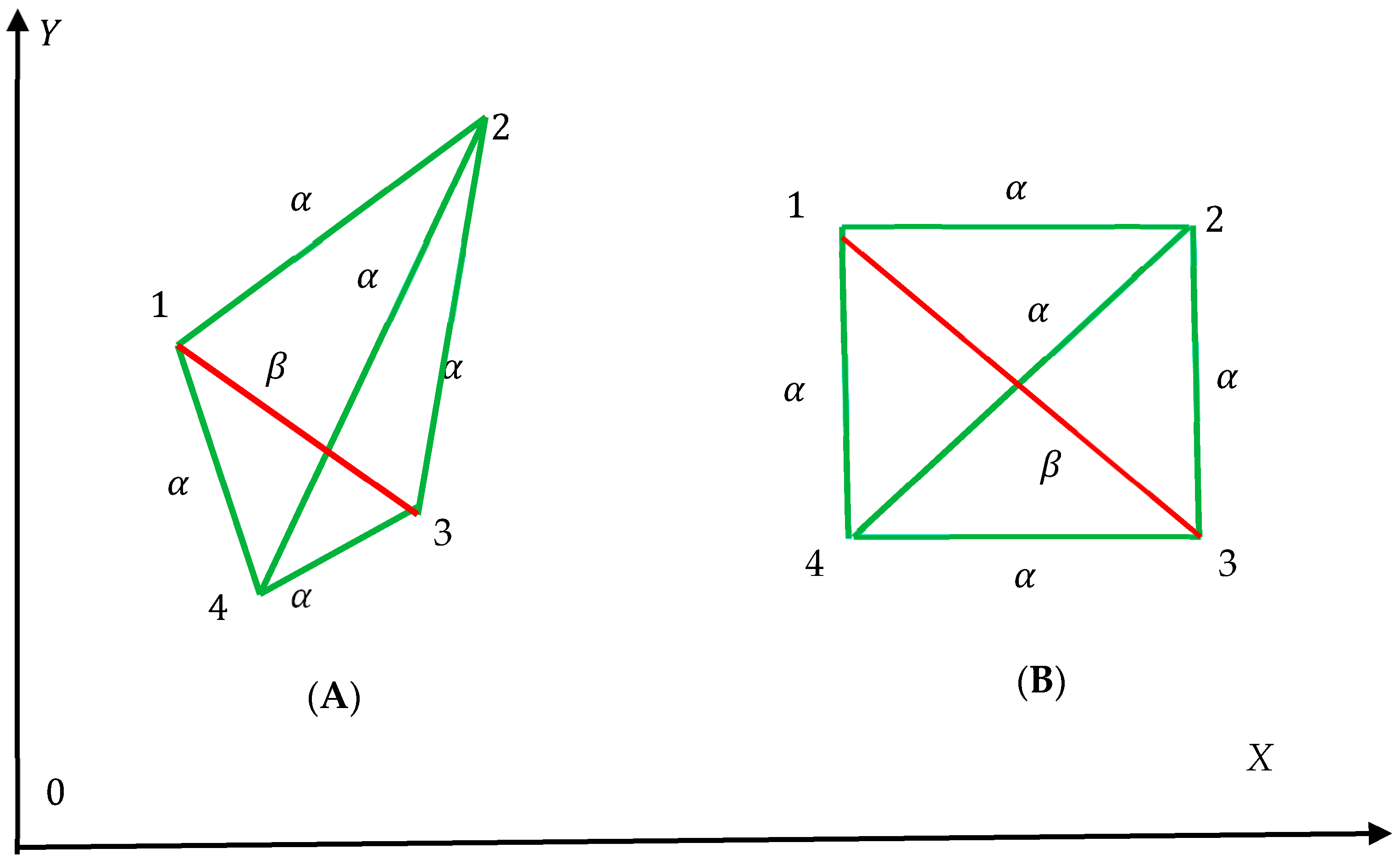
3.3. Shannon Entropy of Complete Bi-Color Graphs Built of Six Vertices
4. Discussion
- (i)
- The paper presents the synthesis of three mathematical ideas, namely: Ramsey complete graphs, Voronoi tessellations, and the Shannon measure of information. We demonstrate that the Shannon entropy may be introduced for the bi-colored graphs in a way similar to that in which it is defined for the Voronoi diagrams/tessellations. For p-colored graphs a set of Shannon entropies should be introduced where is given by:where is the fraction of monochromatic r-colored polygons with n edges. Thus, the matrix of probabilities emerges. Obviously is true.
- (ii)
- Graphs depicted in Figure 1, Figure 2 and Figure 3 are embedded into XOZ coordinate frames. In our recent paper we suggested coloring of the graphs dependent on the orientation of the coordinate axes [25]. Thus, the introduced Shannon Entropies will be also dependent of the orientation of the coordinate axes. We plan to study this dependence in our future investigations.
5. Conclusions
Author Contributions
Funding
Institutional Review Board Statement
Data Availability Statement
Acknowledgments
Conflicts of Interest
References
- Chartrand, G.; Zhang, P. New directions in Ramsey theory. Discrete Math. Lett. 2021, 6, 84–96. [Google Scholar]
- Ramsey, F.P. On a Problem of Formal Logic. In Classic Papers in Combinatorics; Gessel, I., Rota, G.C., Eds.; Modern Birkhäuser Classics; Birkhäuser: Boston, MA, USA, 2009; pp. 264–286. [Google Scholar] [CrossRef]
- Ali, A.; Chartrand, G.; Zhang, P. Irregularity in Graphs; Springer Briefs in Mathematic; Springer Nature: Cham, Switzerland, 2021. [Google Scholar]
- Gerencsér, L.; Gyárfás, A. On Ramsey-type problems. Ann. Univ. Sci. Budapest. Eötvös Sect. Math 1967, 10, 167–170. [Google Scholar]
- Erdős, P.; Gyárfás, A. A variant of the classical Ramsey problem. Combinatorica 1997, 17, 459–467. [Google Scholar] [CrossRef]
- Erdős, P. Solved and unsolved problems in combinatorics and combinatorial number theory. Eur. J. Comb. 1981, 32, 49–62. [Google Scholar]
- Katz, M.; Reimann, J. An Introduction to Ramsey Theory: Fast Functions, Infinity, and Metamathematics, Student Mathematical Library; American Mathematical Society: Providence, RI, USA, 2018; Volume 87, pp. 1–34. [Google Scholar]
- Graham, R.L.; Spencer, J.H. Ramsey Theory. Sci. Am. 1990, 7, 112–117. [Google Scholar] [CrossRef]
- Graham, R.; Butler, S. Rudiments of Ramsey Theory, 2nd ed.; American Mathematical Society: Providence, RI, USA, 2015; pp. 7–46. [Google Scholar]
- Alavi, V.; Lick, D.R.; White, A.T. (Eds.) Graph Theory and Applications: Proceedings of the Conference at Western Michigan University. In the Series Lecture Notes in Mathematics; Springer: Berlin/Heidelberg, Germany, 1972. [Google Scholar]
- Graham, R.L.; Rothschild, B.L.; Spencer, J.H. Ramsey Theory, 2nd ed.; Wiley-Interscience Series in Discrete Mathematics and Optimization; John Wiley &Sons, Inc., A Wiley-Interscience Publication: New York, NY, USA, 1990; pp. 10–110. [Google Scholar]
- Shvalb, N.; Frenkel, M.; Shoval, S.; Bormashenko, E. Dynamic Ramsey Theory of Mechanical Systems Forming a Complete Graph and Vibrations of Cyclic Compounds. Dynamics 2023, 3, 272–281. [Google Scholar] [CrossRef]
- Shvalb, N.; Frenkel, M.; Shoval, S.; Bormashenko, E. Ramsey theory and thermodynamics. Heliyon 2023, 9, e13561. [Google Scholar] [CrossRef]
- Shvalb, N.; Frenkel, M.; Shoval, S.; Bormashenko, E. Universe as a Graph (Ramsey Approach to Analysis of Physical Systems). World J. Phys. 2023, 1, 1–24. [Google Scholar] [CrossRef]
- Roberts, F.S. Applications of Ramsey theory. Discret. Appl. Math. 1984, 9, 251–261. [Google Scholar] [CrossRef]
- Voronoi, G. Nouvelles applications des paramètres continus à la théorie des formes quadratiques. Deuxième mémoire. Re-cherches sur les paralléloèdres primitifs. J. Reine Angew. Math. 1908, 134, 198–287. [Google Scholar] [CrossRef]
- Barthélemy, M. Spatial networks. Phys. Rep. 2011, 499, 1–101. [Google Scholar] [CrossRef]
- Weaire, D.; Rivier, N. Soap, cells and statistics—Random patterns in two dimensions. Contemp. Phys. 1984, 25, 59–99. [Google Scholar] [CrossRef]
- Bormashenko, E.; Frenkel, M.; Vilk, A.; Legchenkova, I.; Fedorets, A.A.; Aktaev, N.E.; Dombrovsky, L.A.; Nosonovsky, M. Characterization of self-assembled 2D patterns with Voronoi Entropy. Entropy 2018, 20, 956. [Google Scholar] [CrossRef] [PubMed]
- Ljaz, A.; Topcu, G.; Miko, A.; Demirel, A.L. Synergistic control of breath figures on Styrene-Butadiene-Styrene films by poly-2-ethyl-2-oxazoline capped CaCl2 loaded mesoporous silica particles. Colloids Surf. A 2023, 672, 131740. [Google Scholar]
- Zhong, T.; Meng, J.; Andrews, M.P. Insights into Permanent Encodings of Macroscopic Spike Patterns by Magnetic-Field-Directed Evaporative Self-Assembly from Ferrofluids. Langmuir 2023, 39, 8186–8195. [Google Scholar] [CrossRef]
- Bormashenko, E.; Legchenkova, I.; Frenkel, M.; Shvalb, N. Voronoi Tessellations and the Shannon Entropy of the Pentagonal Tilings. Entropy 2023, 25, 92. [Google Scholar] [CrossRef]
- Ben-Naim, A. Entropy, Shannon’s Measure of Information and Boltzmann’s H-Theorem. Entropy 2017, 19, 48. [Google Scholar] [CrossRef]
- Shannon, C.E.; Weaver, W. The Mathematical Theory of Communication; The University of Illinois Press: Chicago, IL, USA, 1949; Volume 97, pp. 29–51. [Google Scholar]
- Frenkel, M.; Shoval, S.; Bormashenko, E. Ramsey Theory and Transformations of Coordinate Systems. Preprints 2023. [Google Scholar] [CrossRef]
- Han, J.; Jenssen, M.; Kohayawaka, Y.; Mota, G.O.; Roberts, B. The multicolour size-Ramsey number of powers of paths. J. Combinatorial Theory B 2020, 145, 359–375. [Google Scholar] [CrossRef]
- Radziszowski, S. Small Ramsey numbers. Electron. J. Comb. 2021, 1000, MR1670625. [Google Scholar] [CrossRef]
- Gaitan, F.; Clark, L. Ramsey Numbers and Adiabatic Quantum Computing. Phys. Rev. Lett. 2012, 108, 010501. [Google Scholar] [CrossRef] [PubMed]
- Bian, Z.; Chudak, F.; Macready, W.G.; Clark, L.; Gaitan, F. Experimental Determination of Ramsey Numbers. Phys. Rev. Lett. 2013, 111, 130505. [Google Scholar] [CrossRef] [PubMed]
- Wouters, J.; Giotis, A.; Kang, R.; Schuricht, D.; Fritz, L. Lower bounds for Ramsey numbers as a statistical physics problem. J. Stat. Mech. 2022, 2022, 0332. [Google Scholar] [CrossRef]
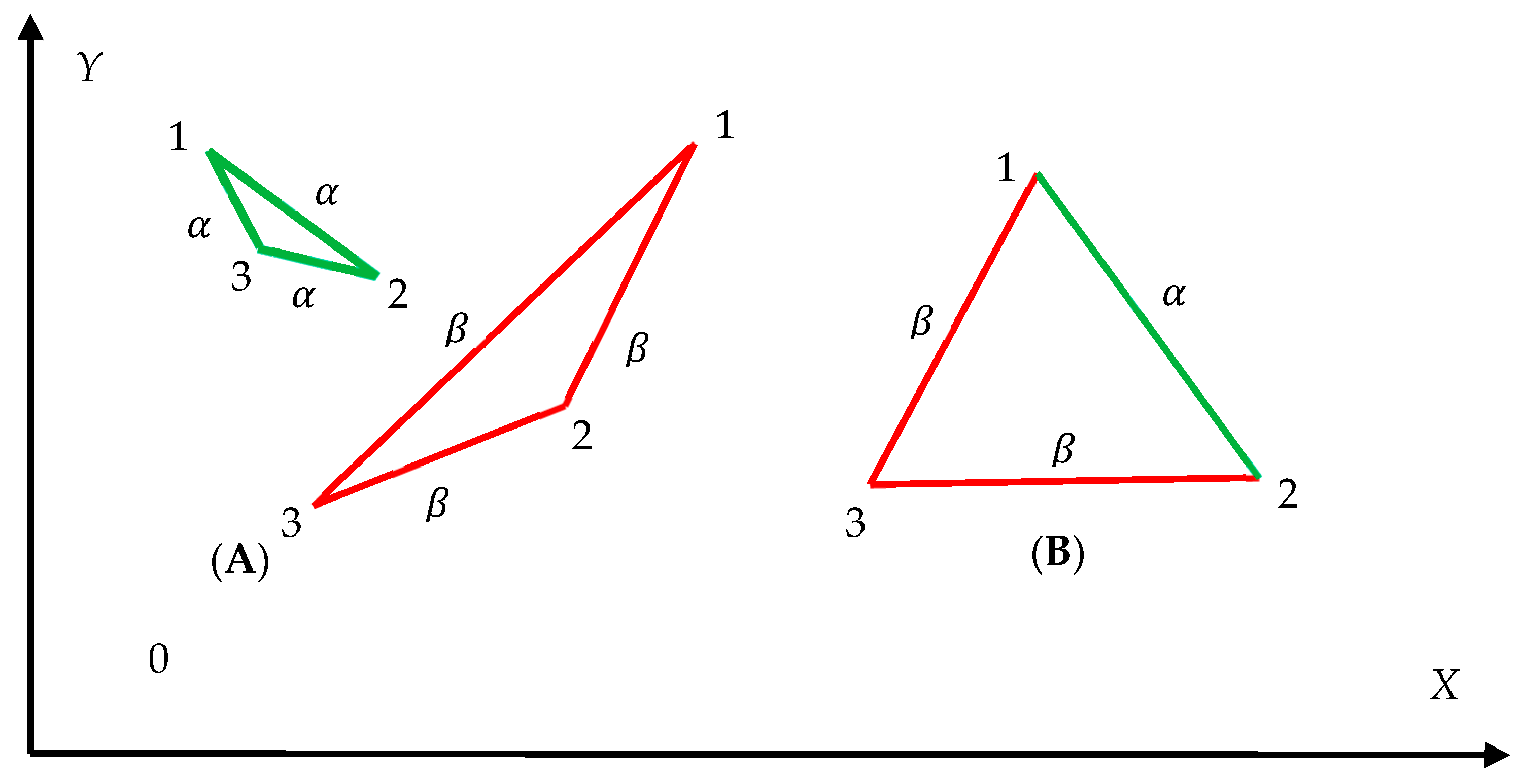
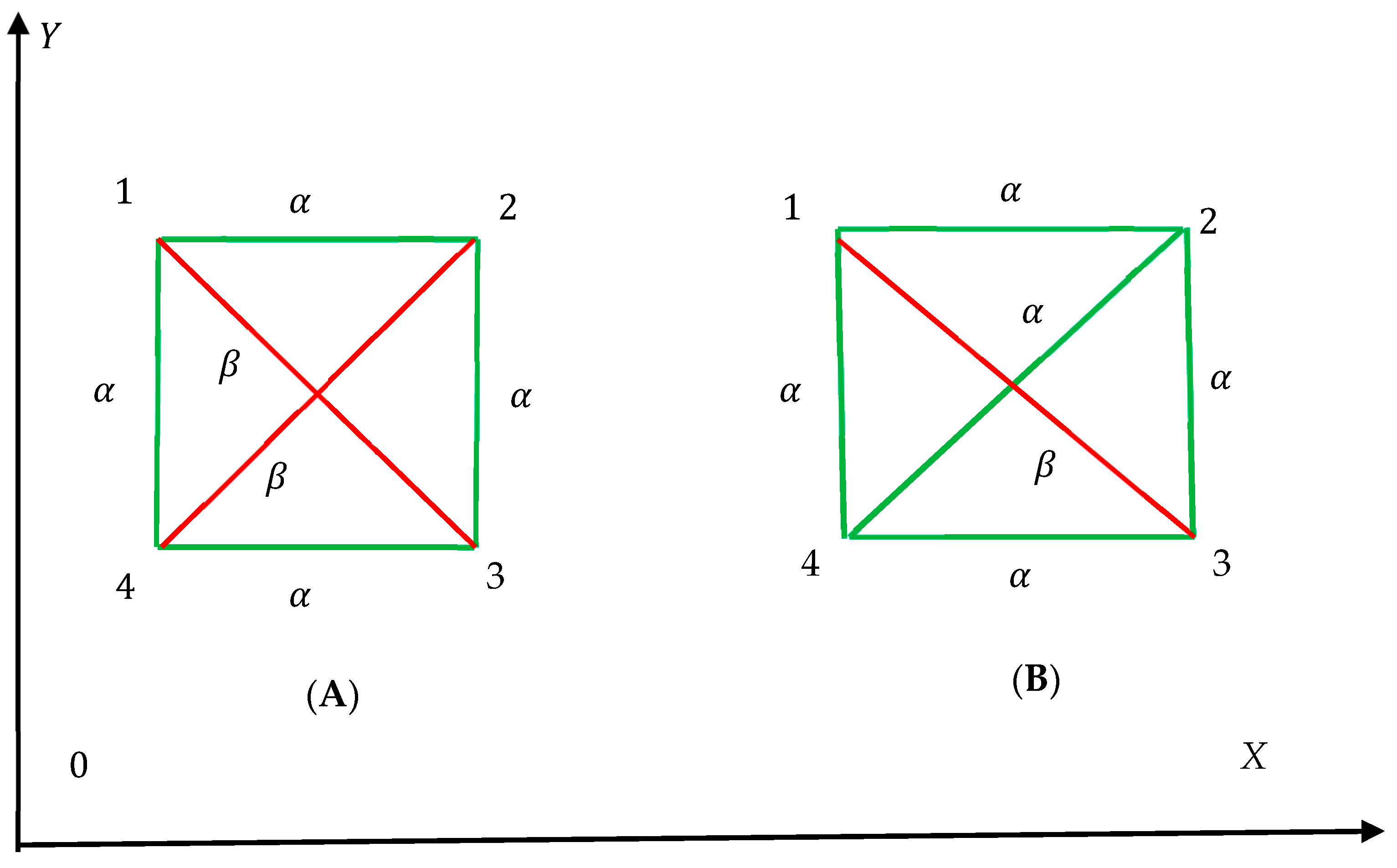
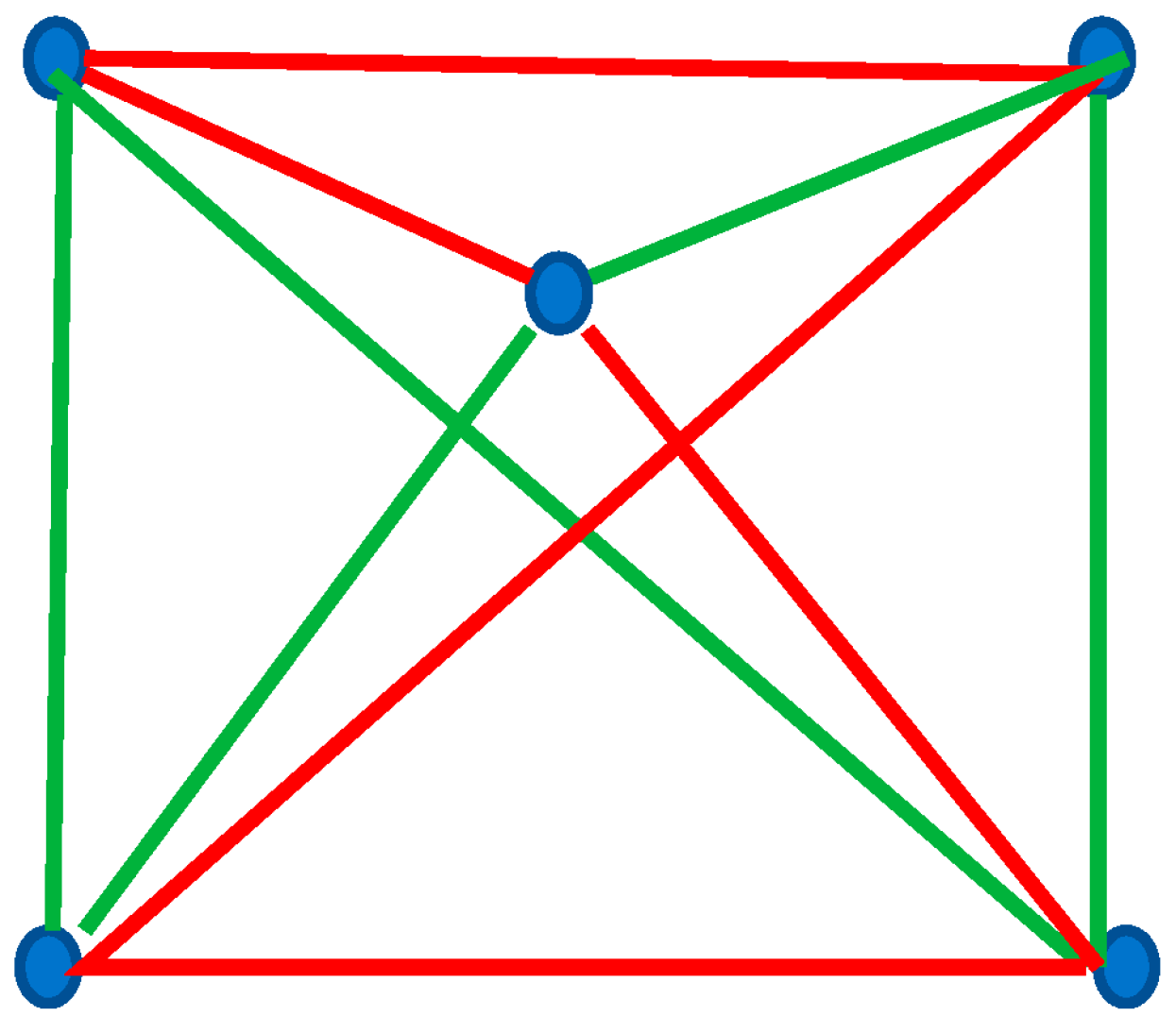
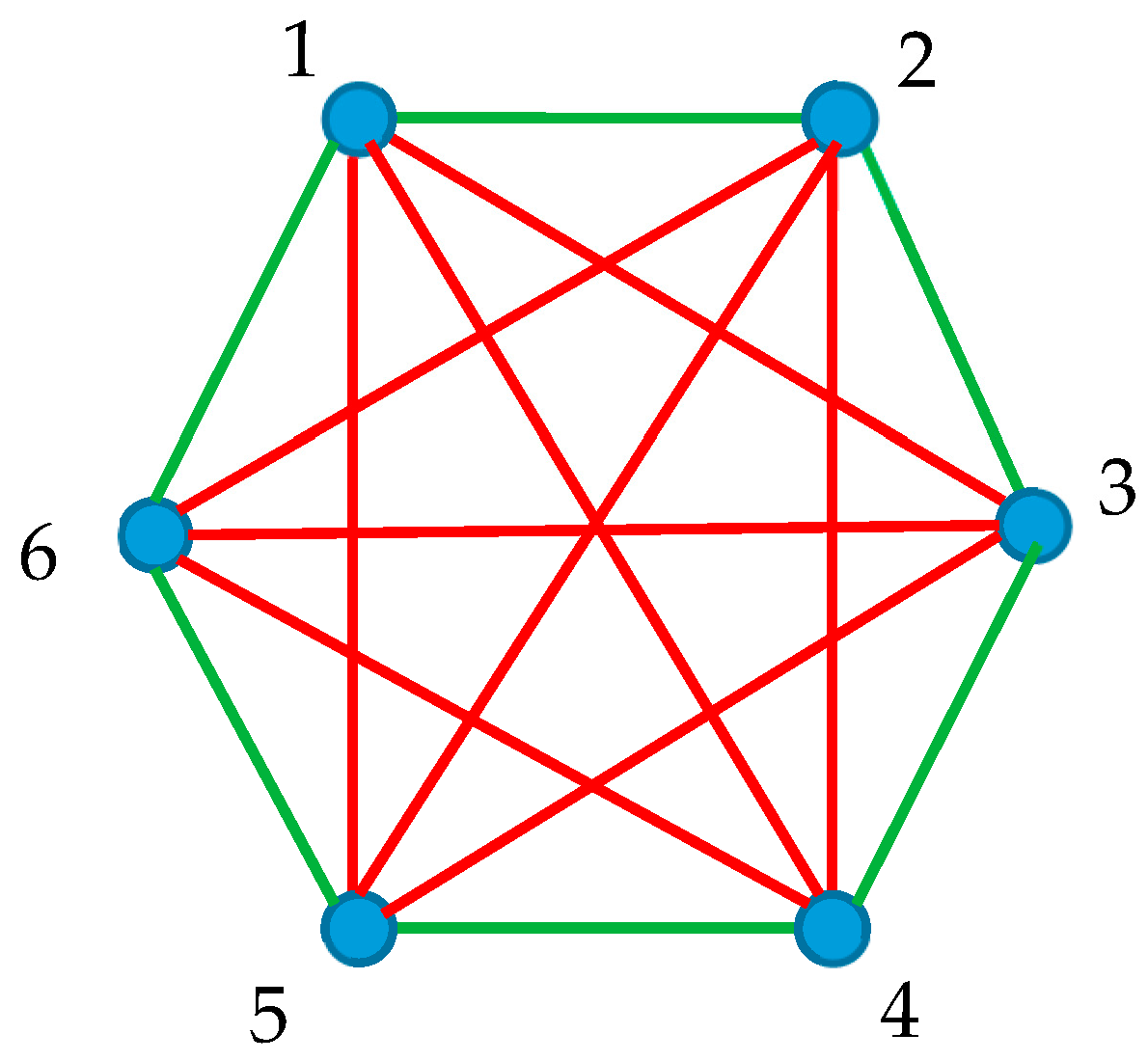
Disclaimer/Publisher’s Note: The statements, opinions and data contained in all publications are solely those of the individual author(s) and contributor(s) and not of MDPI and/or the editor(s). MDPI and/or the editor(s) disclaim responsibility for any injury to people or property resulting from any ideas, methods, instructions or products referred to in the content. |
© 2023 by the authors. Licensee MDPI, Basel, Switzerland. This article is an open access article distributed under the terms and conditions of the Creative Commons Attribution (CC BY) license (https://creativecommons.org/licenses/by/4.0/).
Share and Cite
Frenkel, M.; Shoval, S.; Bormashenko, E. Shannon Entropy of Ramsey Graphs with up to Six Vertices. Entropy 2023, 25, 1427. https://doi.org/10.3390/e25101427
Frenkel M, Shoval S, Bormashenko E. Shannon Entropy of Ramsey Graphs with up to Six Vertices. Entropy. 2023; 25(10):1427. https://doi.org/10.3390/e25101427
Chicago/Turabian StyleFrenkel, Mark, Shraga Shoval, and Edward Bormashenko. 2023. "Shannon Entropy of Ramsey Graphs with up to Six Vertices" Entropy 25, no. 10: 1427. https://doi.org/10.3390/e25101427
APA StyleFrenkel, M., Shoval, S., & Bormashenko, E. (2023). Shannon Entropy of Ramsey Graphs with up to Six Vertices. Entropy, 25(10), 1427. https://doi.org/10.3390/e25101427







